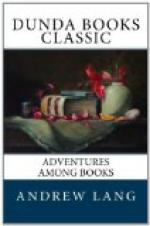Among Dr. Brown’s landscapes, as one may call his descriptions of scenery, and of the ancient historical associations with Scotch scenery, “Minchmoor” is the most important. He had always been a great lover of the Tweed. The walk which he commemorates in “Minchmoor” was taken, if I am not mistaken, in company with Principal Shairp, Professor of Poetry in the University of Oxford, and author of one of the most beautiful of Tweedside songs, a modern “Bush aboon Traquair:”—
“And what
saw ye there,
At the bush aboon
Traquair;
Or what did ye hear that was worth
your heed?
I heard the cushie
croon
Thro’ the
gowden afternoon,
And the Quair burn singing doon
to the vale o’ Tweed.”
There is in the country of Scott no pleasanter walk than that which Dr. Brown took in the summer afternoon. Within a few miles, many places famous in history and ballad may be visited: the road by which Montrose’s men fled from Philiphaugh fight; Traquair House, with the bears on its gates, as on the portals of the Baron of Bradwardine; Williamhope, where Scott and Mungo Park, the African explorer, parted and went their several ways. From the crest of the road you see all the Border hills, the Maiden Paps, the Eildons cloven in three, the Dunion, the Windburg, and so to the distant Cheviots, and Smailholm Tower, where Scott lay when a child, and clapped his hands at the flashes of the lightning, haud sine Dis animosus infans, like Horace.
From the crest of the hill you follow Dr. Brown into the valley of Yarrow, and the deep black pools, now called the “dowie dens,” and so, “through the pomp of cultivated nature,” as Wordsworth says, to the railway at Selkirk, passing the plain where Janet won back Tamlane from the queen of the fairies. All this country was familiar to Dr. Brown, and on one of the last occasions when I met him, he was living at Hollylea, on the Tweed, just above Ashestiel, Scott’s home while he was happy and prosperous, before he had the unhappy thought of building Abbotsford. At the time I speak of, Dr. Brown had long ceased to write, and his health suffered from attacks of melancholy, in which the world




